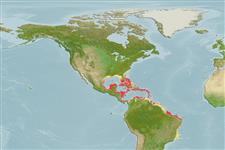分類 / Names
俗名 | 同種異名 | Catalog of Fishes(屬, 種) | ITIS | CoL | WoRMS | Cloffa
Teleostei >
Eupercaria/misc (Various families in series Eupercaria)
鱸形目 (Various families in series Eupercaria) >
Scaridae (Parrotfishes)
鸚哥魚科 (Parrotfishes) > Sparisomatinae
Etymology: Sparisoma: Latin, sparus = a fish with a golden head + Greek, soma = body (Ref. 45335).
More on author: Bonnaterre.
Environment: milieu / climate zone / depth range / distribution range
生態學
海洋 礁區魚類; 深度上下限 3 - 50 m (Ref. 9710). 亞熱帶的; 34°N - 21°S, 98°W - 28°W (Ref. 55284)
Western Atlantic: southern Florida (USA), Bermuda, Bahamas, and throughout the Caribbean Sea to Brazil.
西大西洋: 佛羅里達南部 (美國) ,百慕達群島,巴哈馬, 與在加勒比海到巴西各處。
Length at first maturity / 大小 / 重量 / 年齡
Maturity: Lm 16.3, range 18 - ? cm
Max length : 64.0 cm TL 雄魚/尚未辨別雌雄; (Ref. 3802); common length : 38.0 cm TL 雄魚/尚未辨別雌雄; (Ref. 3802); 最大體重: 1.6 kg (Ref. 26340)
背棘 (總數) : 9; 背的軟條 (總數) : 10; 臀棘: 3; 臀鰭軟條: 9. Relationship between fork length (FL) and maximum body depth (D): D = 0.10 + 0.33(FL); FL = -0.40 + 3.06(D), for n = 79, length range (cm, FL) = 13.5-25.5 (Ref. 3191). A distinctive, colorful and abundant fish. Young adults and females with scales outlined in darker gray; often bright red below. Super males green, with bright yellow spot at upper edge of gill cover, yellow bar at base of tail, curved orange-yellow mark on caudal fin rays (Ref. 26938). Initial phase fish with a brown head, the scales of the upper two-thirds of the body with pale centers and dark brown edges, the lower third of body and fins bright red. Terminal phase males are green with three diagonal orange bands on upper half of head
尾叉長 (FL) 和最大的體高之間的關係:(D) D=0.10+0.33(FL); FL=-0.40 + 3.06(D), 對於 n=79, 長度範圍 (公分, FL)=13.5-25.5.(參考文獻 3191) 一個特殊的﹐色彩鮮豔的與豐富的魚。 年輕的成魚而雌魚有被的邊緣的鱗片深灰色; 時常下面鮮紅色的。 超級雄性綠色, 在鰓蓋的上緣有鮮黃色的斑點, 在尾鰭鰭條上被彎曲橘黃色的標誌的尾部的基底黃色的橫帶.(參考文獻 26938) 初期階段魚具有一個褐色頭部, 身體有的上面三分之二的鱗片灰白的中心與深褐色的邊緣, 下面的身體中的第三與鰭鮮紅色。 最後階段雄性是在頭部的上半部上綠色的有三條斜的橘色條紋
Inhabits coral reefs with clear water (Ref. 13628). Young may be found in seagrass beds and other heavily vegetated bottoms. Feeds mainly on soft algae, but has been observed to graze on live corals like, Montastraea annularis (Ref. 6496). Produces a significant amount of sediment through bioerosion using its strong beak-like jaws and constantly re-growing teeth (Ref. 6485). Protogynous; strictly diurnal, spends the night sleeping on the bottom (Ref. 5221). Found singly or small in small groups.
棲息於珊瑚礁,水質清澈的地方.(參考文獻 13628) 幼魚可能被發現於海草床與其他的長滿植物的底部。 主要吃軟的藻類, 但是已經被觀察啃食活珊瑚例如 Montastraea annularis.(參考文獻 6496) 產生一個穿過使用它的強鳥嘴形的顎與不斷再成長的齒的生物侵蝕重要量的沉澱物。 (參考文獻 6485) 雌性先熟的; 嚴格日行性, 在底部上度過夜晚睡眠.(參考文獻 5221) 各別地發現或小的形成小群魚群。
Life cycle and mating behavior
Maturities | 繁殖 | Spawnings | Egg(s) | Fecundities | 仔魚
The type of reproductive behavior is related to the color phase of the males involved. 西大西洋: 佛羅里達南部 (美國) ,百慕達群島,巴哈馬, 與在加勒比海到巴西各處。
Cervigón, F., R. Cipriani, W. Fischer, L. Garibaldi, M. Hendrickx, A.J. Lemus, R. Márquez, J.M. Poutiers, G. Robaina and B. Rodriguez, 1992. Fichas FAO de identificación de especies para los fines de la pesca. Guía de campo de las especies comerciales marinas y de aquas salobres de la costa septentrional de Sur América. FAO, Rome. 513 p. Preparado con el financiamento de la Comisión de Comunidades Europeas y de NORAD. (Ref. 5217)
IUCN 瀕危狀態 (Ref. 130435)
無危 (LC) ; Date assessed: 15 September 2009
人類使用
漁業: 低經濟; 水族館: 商業性
工具
特別的報告
下載 XML
網路資源
Estimates based on models
Preferred temperature (Ref.
123201): 25.4 - 28, mean 27.2 °C (based on 206 cells).
Phylogenetic diversity index (Ref.
82804): PD
50 = 0.5000 [Uniqueness, from 0.5 = low to 2.0 = high].
Bayesian length-weight: a=0.01380 (0.00901 - 0.02115), b=3.05 (2.93 - 3.17), in cm total length, based on LWR estimates for this species & Genus-body shape (Ref.
93245).
營養階層 (Ref.
69278): 2.0 ±0.00 se; based on food items.
Generation time: 2.4 ( na - na) years. Estimated as median ln(3)/K based on 2
growth studies.
回復力 (Ref.
120179): 中等的, 族群倍增時間最少 1.4 - 4.4年 (tmax=9; k >0.30).
Prior r = 1.04, 95% CL = 0.68 - 1.56, Based on 1 data-limited stock assessment.
Fishing Vulnerability (Ref.
59153): Low to moderate vulnerability (31 of 100).
Nutrients (Ref.
124155): Calcium = 23.5 [12.5, 48.3] mg/100g; Iron = 0.649 [0.330, 1.159] mg/100g; Protein = 19.1 [17.0, 21.5] %; Omega3 = 0.152 [0.082, 0.269] g/100g; Selenium = 19 [9, 40] μg/100g; VitaminA = 21.8 [5.8, 80.5] μg/100g; Zinc = 0.943 [0.615, 1.606] mg/100g (wet weight);
